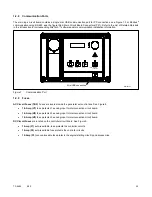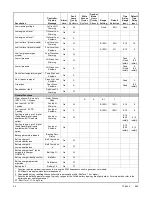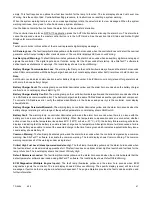
TP-6694
9/20
43
Section 2. Operation
2.1 Prestart Checklist
To ensure continued satisfactory operation, perform the following checks or inspections before or at each startup, as designated,
and at the intervals specified in the service schedule. In addition, some checks require verification after the unit starts.
DANGER
Hazardous voltage. Moving parts.
Will cause severe injury or death.
Operate the generator set only when all guards and electrical enclosures are in place.
Air Cleaner.
Check for a clean and installed air cleaner element to prevent unfiltered air from entering engine.
Air Inlets.
Check for clean and unobstructed air inlets.
Battery.
Check for tight battery connections. Consult the battery manufacturer’s instructions regarding battery care and
maintenance.
Coolant Level.
Check the coolant level according to the cooling system maintenance information.
Note:
Block Heater Damage.
The block heater will fail if the energized heater element is not immersed in coolant. Fill the cooling
system before turning on the block heater. Run the engine until it is warm, and refill the radiator to purge the air from the system
before energizing the block heater.
Drive Belts.
Check the belt condition and tension of the radiator fan, water pump, and battery charging alternator belt(s)
according to the drive belt system maintenance information.
Exhaust System.
Check for exhaust leaks and blockages. Check the silencer and piping condition and check for tight exhaust
system connections.
Inspect the exhaust system components (exhaust manifold, exhaust line, flexible exhaust, clamps, silencer, and outlet pipe) for
cracks, leaks, and corrosion.
Check for corroded or broken metal parts and replace them as needed.
Check for loose, corroded, or missing clamps and hangers. Tighten or replace the exhaust clamps and/or hangers as
needed.
Check that the exhaust outlet is unobstructed.
Visually inspect for exhaust leaks
(blowby).
Check for carbon or soot residue on exhaust components. Carbon and soot
residue indicates an exhaust leak. Seal leaks as needed.
Fuel Level.
Check the fuel level and keep the tank(s) full to ensure adequate fuel supply.
Oil Level.
Maintain the oil level at or near, not over, the full mark on the dipstick.
Operating Area.
Check for obstructions that could block the flow of cooling air. Keep the air intake area clean. Do not leave
rags, tools, or debris on or near the generator set.
Summary of Contents for APM402
Page 6: ...6 TP 6694 9 20 ...
Page 16: ...16 TP 6694 9 20 ...
Page 42: ...42 TP 6694 9 20 ...
Page 78: ...78 TP 6694 9 20 ...
Page 112: ...112 TP 6694 9 20 ...
Page 120: ...120 TP 6694 9 20 ...
Page 124: ...124 TP 6694 9 20 Figure 54 20 150 kW Permanent Magnet Single Phase Alternators ADV 5875AB 1 ...
Page 125: ...TP 6694 9 20 125 Figure 55 20 300 kW Permanent Magnet Alternators ADV 5875AB 2 ...
Page 128: ...128 TP 6694 9 20 ...
Page 131: ...TP 6694 9 20 131 Figure 61 Battery Charger to Controller Connections DEC 3000 Controller ...
Page 153: ...TP 6694 9 20 153 Figure 90 Controller Wiring Connections GM78246G 1 ...
Page 154: ...154 TP 6694 9 20 Figure 91 Controller Wiring Connections GM78246G 2 ...
Page 171: ......
















































